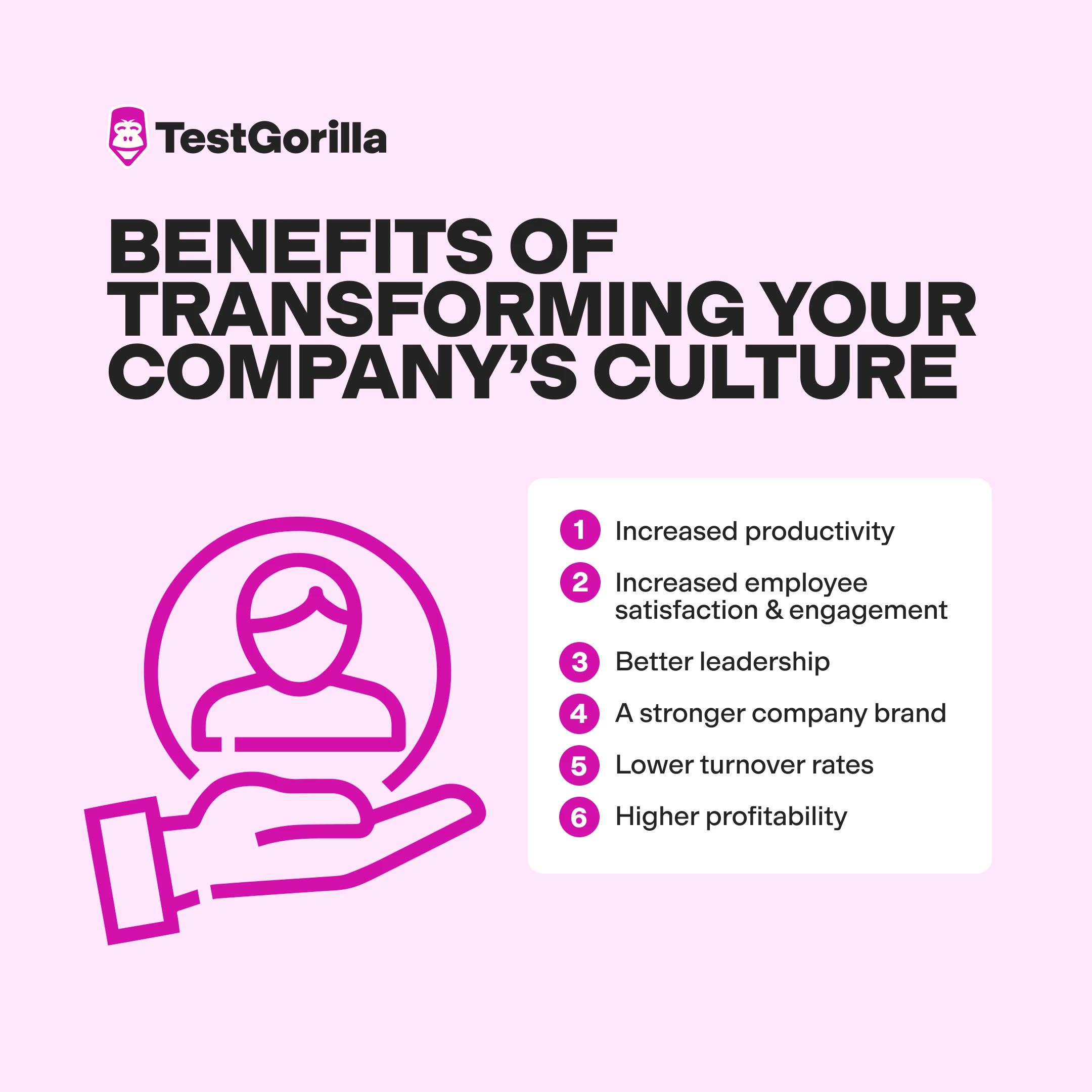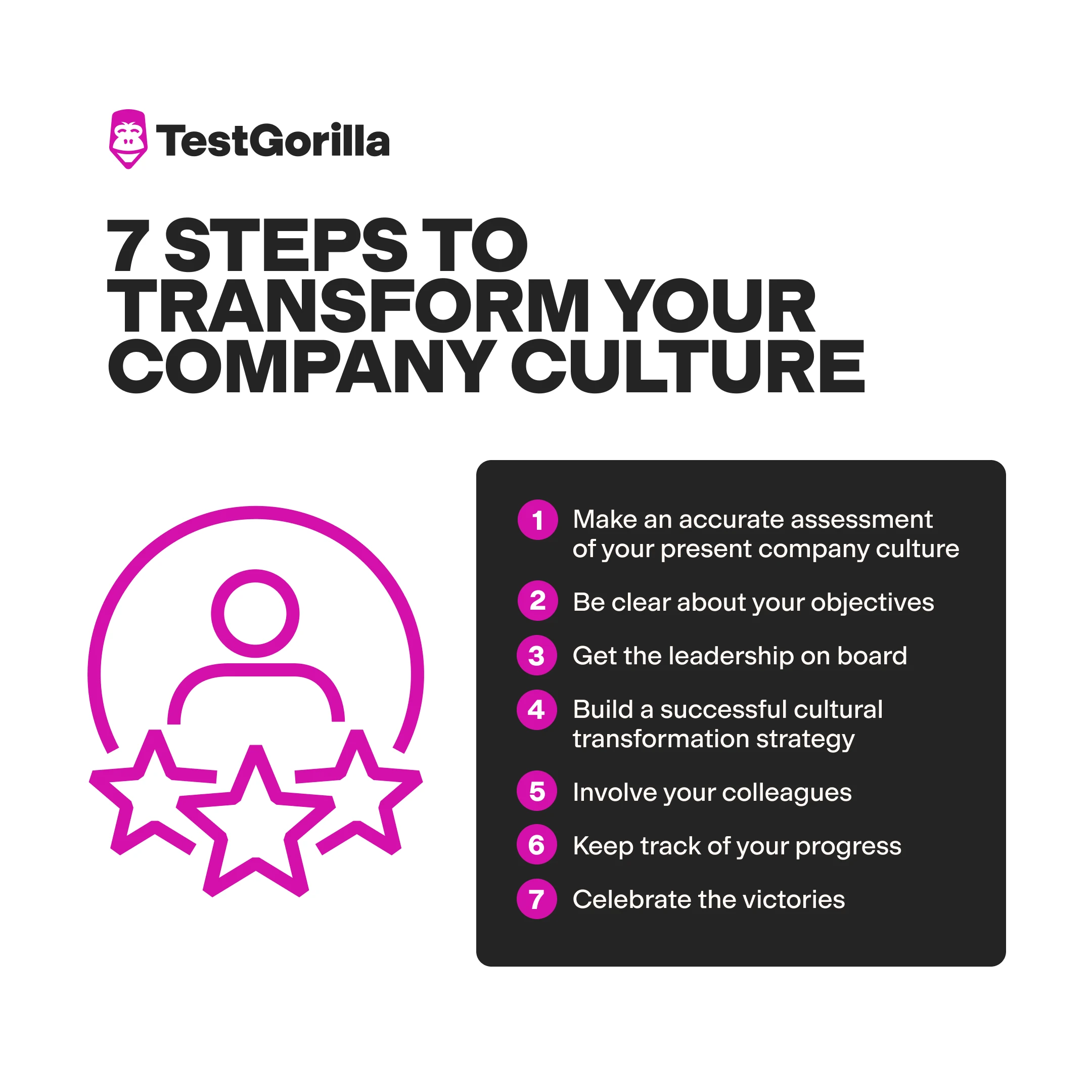7 steps to a thriving workplace: A guide to cultural transformation
Transform your company culture using talent assessments
The interplay between the standard behaviors in your workplace, the way you hire and fire, and how you treat employees daily describes your company culture and impacts your business at all levels.
You can tell a culture is negative if the workers are chronically stressed or cynical.
Cultural transformation in organizations creates an empowering work environment for everyone and drives the business forward.
In this article, we help you plan and execute your cultural transformation strategy with several steps, like getting the leadership on board and talent assessments.
Table of contents
- What is cultural transformation?
- The business benefits: Why does your company need a cultural transformation?
- The right moment: When does your company need cultural transformation?
- 7 steps to transforming culture in your company
- Cultural transformation is worth the investment
- Company cultural transformation FAQs
What is cultural transformation?
Cultural transformation in the workplace is a collective, long-term commitment to building an environment that supports all workers and sustainably helps your business evolve. The process includes examining your current company culture, updating your policies to reflect company values, and creating a cultural transformation strategy to implement these new rules consistently on all levels. You can read our article about cultural transformation examples to see how it worked out for other businesses.
The business benefits: Why does your company need a cultural transformation?
So, what is the importance of cultural transformation?
As many as 40% of US respondents reported feeling emotionally and physically isolated at their workplace.
It’s crucial for any organization to change that because, according to HBR, having workers who feel like they belong in the company they work for leads to:
56% increase in job performance
50% drop in turnover risk
75% reduction in sick days
167% increase in the employer promoter score (the employee’s willingness to promote their company to others)
As you can see, it’s a win-win situation: Keeping your employees happy and inspired gets them invested in the long-term success of your business.
To keep you and your employees committed to the process, here is a list of the results that transforming your company’s culture brings.
Benefit | Explanation |
Increased productivity | Being a good employer results in increased employee dedication to your company's success. |
Increased employee satisfaction and engagement | According to Frederick Herzberg’s motivation theory, the five fundamentals of employee satisfaction are:
- Doing what suits you - For the right reasons - With the right people - There is an easy feedback flow - Growth is encouraged
These motivating factors rely on a strong and engaging company culture |
Better leadership | Good leadership is essential to creating a healthy culture, but it also works the other way around: A strong culture naturally shapes fair leaders who embody company values and promote the business. |
A stronger company brand | People can gauge your culture from your employees’ satisfaction level, candidate experience, and how you treat your customers. When your culture is healthy, it promotes loyalty and attracts more candidates. |
Lower turnover rates | Happy, supported employees who are recognized for their efforts tend to stick around their companies longer. |
Higher profitability | By fostering a positive culture, you unlock the full potential of your workforce, minimize your expenses, and improve your business bottom line. |
Hire the ideal culture adds with TestGorilla
With skills assessments, you can gauge your candidates’ alignment with your company values and ensure you hire the people who positively contribute to your culture. See how easy it is in our live demo.
The best insights on HR and recruitment, delivered to your inbox.
Biweekly updates. No spam. Unsubscribe any time.
The right moment: When does your company need cultural transformation?
Here are some indications that you need an organizational culture transformation.
1. Low employee satisfaction
Employee dissatisfaction decreases productivity and negatively impacts your organization’s reputation.
When you create a positive company culture that seeks to support and inspire people, employees are more likely to be engaged, think outside the box, or go the extra mile to support your company.
Hiring the right people to help you build this environment is crucial. You don’t want to fall into the trap of always hiring the same type of person.
All hires need to share your ethics and align with your core values, but opening doors to diverse candidates with unique strengths, perspectives, and needs naturally contributes to an inclusive environment that supports all employees – not just a certain type.
Our Culture Add test is the best way to assess how each candidate can contribute to your cultural transformation.
For example, TakeFortyTwo used ad hoc tests and manual evaluation in the past, but the results were imprecise, and the whole process was time-consuming. Since it switched to TestGorilla, TakeFortyTwo has been able to accurately determine cultural compatibility and improve its hiring process.
Unlock the power of multi-measure testing with TestGorilla
With our talent assessments, you can measure candidates’ hard and soft skills, cognitive abilities, cultural alignment, language, personality traits, and more. Create your free account and get started today.
2. High new hire turnover
Proper onboarding and strong company culture play a big part in retaining your new hires. People who feel they belong in their workplace want to stay and contribute to its development.
On the other hand, when an organization has unclear values and purpose, new employees find it difficult to build loyalty, which leads to high turnover rates among new hires.
It may not sound so bad that employees with less experience and motivation leave, but you risk losing potential high performers. Besides, the cost of turnover is extremely high.
3. Consistently low company revenue
Every organization has unexpected costs or may go through economic or industry crises that result in low company revenue.
However, there’s usually more to the story than that. Don’t let external factors derail you from looking into your company culture and addressing the things that are in your control and contribute to low revenue. More often than not, there are steps you can take to improve your situation.
Cultural transformation can help your company weather the storm, even if it’s caused externally.
4. New markets or opportunities are available
When a good business opportunity lies ahead, it’s crucial to prepare your employees. Working with new partners or discovering new markets requires a shift in your company culture that can help you achieve your goals.
During the past five years, many businesses had to work remotely for the first time. As a result, many have now moved to a hybrid model, which requires transforming the company culture.
7 steps to transforming culture in your company
Follow our seven-step cultural transformation strategy to build a lasting, thriving workplace.
1. Make an accurate assessment of your present company culture
Company culture often doesn’t show up in company performance metrics because it seems too abstract and vague to quantify. As a result, monitoring and maintaining your ideal culture becomes impossible.
However, you need to know where you stand to make the right culture changes, and it’s a simple process if you use talent assessments.
TestGorilla’s Culture Add test is commonly used during hiring to evaluate and compare how well candidates match the company values based on the employer’s previous input. It can also be used internally with employees. Here is a preview from the employer’s perspective:
The process is simple:
The employer completes the blank questionnaire to set benchmark values
Employees complete the test, and their results are stacked against the benchmark
The results show your cultural compatibility with existing employees and flag any stark contrasts you need to address in your existing culture.
Assessing your organizational culture is your starting point for cultural transformation in business.
Use TestGorilla to unlock the power of talent assessments
Getting started with TestGorilla is easy and 100% free. All you need to do is sign up and start picking the most relevant tests for any role, skill, or trait.
2. Be clear about your objectives
Define your goals clearly to direct your efforts efficiently to avoid wasting resources on unnecessary change.
You can use the results from our Culture Add test to identify the gap between your ideal and your current culture.
Next, you want to get more specific and identify the most burning issues so you can prioritize them in the right order. For that, you need more reflection:
Ask your workforce for feedback: What’s the atmosphere like in the company? How long does everyone typically work? Do team members have overall good relationships? What are their biggest problems and frustrations at work?
Do a “health check” of the company: Look at your retention, turnover rate, employee engagement, and performance metrics. Does any particular area need more attention than others?
You should also look at your standard operating procedures, especially when it comes to employee recognition and performance management.
For instance, what are the elements you consider in employee performance reviews? If you only look at quotas and deliverables, you signal to employees that you only care about the numbers and miss out on the opportunity to facilitate your other company values.
At the end of this stage, you should have a solid idea of some practices that hinder your progress and previously missed chances to facilitate your culture proactively.
3. Get the leadership on board
There are many examples of poor leadership running a successful company into the ground. An infamous case of a leader developing a bad company culture is the story of WorldCom and its chief executive, Bernie Ebbers.
His poor decision-making and the fact that he pressured employees into working harder without any incentives just so he could profit personally affected the entire organization and led to the bankruptcy of a former telecom leader.
A strong organizational culture has leaders who reflect the company’s mission, values, and ethics. Employees are inspired by the people in leadership positions and reflect their behavior and perspectives.
That’s why it’s imperative to get leadership buy-in for your cultural transformation.
Make sure the leaders in your company understand your company’s values and are acquainted with the new behavior changes you want to emulate.
Their role in change management and cultural transformation includes:
Modeling and recognizing desirable behaviors such as good teamwork or employee initiative
Patiently guiding employees during the company's organizational transformation
Being attuned to coworkers and taking an interest in their wellbeing
Making interventions to correct undesirable behaviors like disrespectful communication and upholding company policies
Communicating clearly to limit confusion and mistakes along the way
4. Build a successful cultural transformation strategy
After you get a clear idea of what you want to achieve, it’s time to build a business strategy and an actionable plan.
Start by mapping out a limited number of clear goals that are easy to measure and determining what steps you can take to achieve them.
You can use these cultural transformation models for guidance:
Model | Explanation |
The 7-S model breaks an organization’s culture down into hard elements (strategy, structures, and systems) and soft elements (shared values, skill, style, staff). All of these need to be balanced in the right order, starting with shared values – the most important element. | |
In three stages, this model guides you to:
Unfreeze: challenge the current norm Implement changes on a trial-and-error basis Refreeze: facilitate the new status quo in the company | |
Kotter’s 8 Steps Model | Kotter’s comprehensive model offers the most structured framework for executing the change process:
1. Create a sense of urgency 2. Build a guiding coalition 3. Form a strategic vision and initiatives 4. Enlist a volunteer army 5. Enable action by removing barriers 6. Generate short-term wins 7. Sustain acceleration 8. Institute change |
Whichever cultural transformation model you choose, make sure your approach includes all three layers of organizational culture:
Core values that represent your company’s essence and mission
Norms – the informal rules that structure the interactions within the company and its members
Behaviors that reflect the values and norms outwardly
5. Involve your colleagues
Inviting colleagues to become stakeholders in your corporate culture transformation guarantees they understand the organization’s values and feel connected to them.
Involve them in the process. Provide them with space to give you feedback about the changes, recognize their competencies and efforts, and encourage them to set boundaries at work.
Getting the entire workforce on board has significant benefits:
Everyone feels heard and valued and shares ownership of the culture
Your combined ideas cover all angles, leading to a smoother roadmap to success
You reduce the chances of forgetting something important
You start building trust with colleagues by putting words into action
6. Keep track of your progress
There are four key areas that you have to measure to ensure you’re moving in the right direction and learning from mistakes:
Behavioral shifts: Are employees embracing the cultural transformation process? How are they reacting to the new norms? Are their services more aligned with the image your company wants to introduce to its customers?
Business performance: Set up key performance metrics to track your company’s performance during each stage of the cultural transformation. Are you reaching your growth targets? Is there more room for expansion?
Milestones: Keep your eye on a few clearly defined desired results.
Reaction to company culture transformation: How do the employees feel about the organizational change that is taking place? Is it significant to them? Run surveys and ask for feedback.
Make sure that each change has a supporting structure to make it truly “official” and sustainable.
For example, if you’re working on eliminating silos between teams, you can make it a rule to exchange reports in regular intervals, set times for meetings or collaboration, and include communication and teamwork in individual performance reports to engage everyone.
Remember to leave some room for adjustments and prepare multiple options if your initial idea doesn’t integrate perfectly.
7. Celebrate the victories
Set short-term and long-term goals. Quick wins have a motivational effect on people and enable you to keep up the momentum. Celebrate these victories with your employees so you can stay motivated for the longer-term change.
Cultural transformation is worth the investment
Company culture transformation is a long-term project that requires commitment and a well-defined strategy – and making the right hiring decisions enables you to move more quickly in the right direction.
Our tests, like the Culture Add test and Motivation tests, enable you to assess and hire people whose values add to yours.
Request a demo to see how TestGorilla can help with your organizational culture transformation process.
If you’re ready to begin, sign up for the Free forever plan.
Company cultural transformation FAQs
Below are the bite-sized answers that explain the importance of cultural transformation in organizations.
How do you lead a cultural transformation?
Make an accurate assessment of your present company culture
Be clear about your objectives and map out your desired culture
Get the leadership team on board
Build a cultural transformation strategy to enact all the changes
Involve all colleagues
Keep track of your progress
Celebrate the victories
What questions should you ask ahead of company culture transformation?
What are the company’s core values, and how are they practiced in reality?
Are there any perception and experience differences between employees and management?
Is the company culture currently monitored and tied to performance metrics?
How effective is your communication?
Do employees trust leadership and feel valued?
Are all workers fairly compensated and recognized for their work?
Are employees encouraged to give feedback, and how are their complaints handled?
How do you currently evaluate a cultural match when hiring new employees?
What makes cultural transformation in business last?
The organization’s commitment to creating clear policies, modeling expectations, and consistently enforcing the rules to create a healthy cultural transformation. It starts with leadership, but all workers must adhere to and contribute in positive ways for the new culture to stay healthy.
You've scrolled this far
Why not try TestGorilla for free, and see what happens when you put skills first.





















